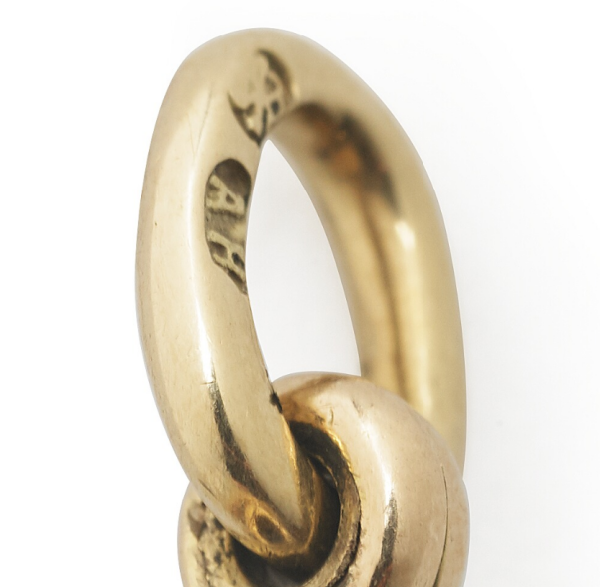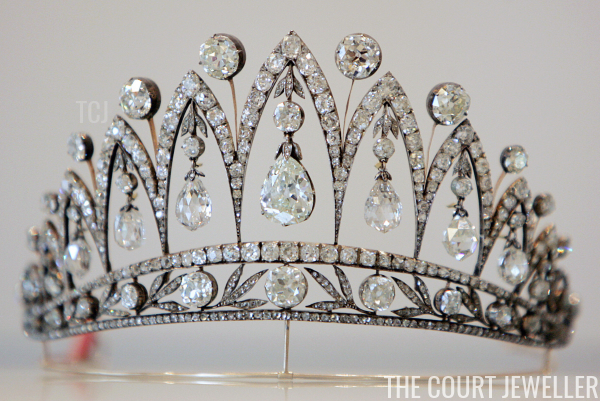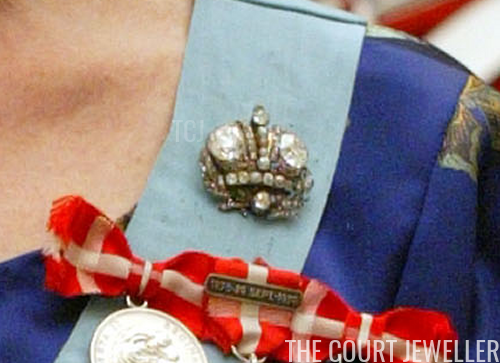 |
| Bruun Rasmussen |
Fabergé lovers rejoice: a royal Easter egg pendant has resurfaced, and it will be sold at auction in June! Here are all the details on this unusual nautical egg.
 |
| Bruun Rasmussen |
The egg pendant will be sold by Danish auction house Bruun Rasmussen. Their notes describe it as “a Russian Easter egg pendant with blue translucent enamel on guilloched ground, set with anchor formed 14k gold cagework.” The bauble was made in St. Petersburg at the end of the nineteenth century.
 |
| Bruun Rasmussen |
The pendant was made by August Holmström, the Finnish-born craftsman who served as Fabergé’s head jeweler at the end of the nineteenth century. His son, daughter, and granddaughter were also talented jewelers who produced notable work for the firm.
 |
| MEHDI FEDOUACH/AFP/Getty Images |
Holmström’s name may be familiar to you because he also crafted some other interesting royal jewels. He produced the Leuchtenberg Fabergé Tiara around 1890…
 |
| Christie’s |
…and this spectacular star sapphire and diamond pendant brooch, made ca. 1900 for Grand Duchess Maria Pavlovna, who is better known to us as Grand Duchess Vladimir.
 |
| Bruun Rasmussen |
Here’s a closer look at the egg pendant, with its bright golden anchors and its luminous enamel and Guilloché work, which reminds me a little of fish scales or even tiny waves. There’s a strong emphasis here on the word “tiny,” as the entire pendant, including its loop, measures in at a petite 2.5 centimeters.
 |
| Carlos Alvarez/Getty Images |
You can get a better sense of the scale of these pendants in this photo of Queen Sofia of Spain, who often wears a necklace full of egg pendants for Easter Sunday services in Palma de Mallorca. Many think at least some of her pendants could be Fabergé pieces.
 |
| Wikimedia Commons |
The first known royal owner of the nautical egg pendant was, appropriately enough, a Romanov. Grand Duchess Anastasia Mikhailovna was a granddaughter of Tsar Nicholas I. In 1879, she married Grand Duke Friedrich Franz III of Mecklenburg-Schwerin. She was a fascinating and sometimes scandalous royal woman, with an affinity for gambling and beautiful jewelry. Like many members of her family, she was also a major admirer of Fabergé.
 |
| Christie’s |
In fact, Anastasia loved Fabergé so much that she helped engineer the creations of two magnificent tiaras from the firm at the start of the twentieth century. This diamond and aquamarine stunner was made by the jeweler as a wedding present for her new daughter-in-law, Princess Alexandra of Hanover, in 1904. Anastasia had encouraged her son, Grand Duke Friedrich Franz IV, to secure a Fabergé tiara to offer his new wife as her wedding present, and this piece was the result.
 |
| Sotheby’s |
A year later, Anastasia was again involved in the creation of another sparkler. This diamond tiara was a wedding gift to Anastasia’s younger daughter, Cecilie, on her marriage to Crown Prince Wilhelm of Germany in 1905. The piece was given to Cecilie by a group of her Russian imperial relatives, and correspondence about the tiara between the jewelry firm and Anastasia herself reportedly exists.
 |
| Wikimedia Commons |
The nautical egg pendant ended up with Anastasia’s elder daughter, Alexandrine. In 1898, Alexandrine married the future King Christian IX of Denmark. When Anastasia gifted or bequeathed the pendant to Queen Alexandrine, the piece became a part of the Danish royal family’s collection.
 |
| Wikimedia Commons, Sean Gallup/Getty Images |
From Queen Alexandrine, the pendant passed to her younger son, Hereditary Prince Knud. And then, from him, the pendant moved into the collection of his only daughter, Princess Elisabeth of Denmark. She inherited several pieces of grand jewelry from Anastasia and Alexandrine.
 |
| Sean Gallup/Getty Images |
Along with the egg pendant, Elisabeth was also the proud owner of the diamond brooch that Anastasia received when she attended the coronation of Emperor Nicholas II and Empress Alexandra in 1896. The new imperial couple commissioned brooches in the shape of the Russian imperial crown as gifts for each of the grand duchesses attending the festivities. Like the egg, the brooch is also the work of Fabergé. When Elisabeth died in 2018, she bequeathed the brooch to the Danish Royal Collection, to be housed at the Amalienborg Museum.
 |
| Bruun Rasmussen |
The egg pendant is currently owned by a Danish private citizen, and Bruun Rasmussen will sell it in their auction of Russian items on June 10. It can be yours for an estimated 30,000-50,000 Danish krone (or about $4400-$7400 USD)! (See the whole auction catalogue here!)
Leave a Reply